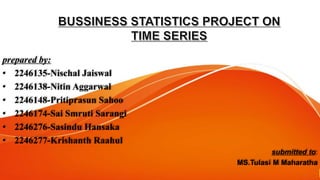
TIME SERIES
- 1. prepared by: • 2246135-Nischal Jaiswal • 2246138-Nitin Aggarwal • 2246148-Pritiprasun Sahoo • 2246174-Sai Smruti Sarangi • 2246276-Sasindu Hansaka • 2246277-Krishanth Raahul submitted to: MS.Tulasi M Maharatha
- 2. Contents : 1. INTRODUCTION AND DEFINATION OF TIME SERIES . 2. COMPONENTS OF TIME SERIES . 3. USES OF SEASONAL INDICES . 4. ONE BASIC EXAMPLE OF SEASONAL INDICES .
- 3. Introduction: We know that planning about future is very necessary for the every business firm, every govt. institute, every individual and for every country. Every family is also doing planning for his income expenditure. As like every business is doing planning for possibilities of its financial resources & sales and for maximization its profit. ,,Definations : "A time series is a set of observation taken at specified times, usually at equal intervals". "A time series may be defined as a collection of reading belonging to different time periods of some economic or composite variables". By-Ya-Lun-Chau • Time series establish relation between "cause" & "Effects" • One variable is "Time" which is independent variable & and the second is "Data" which is the dependent variable.
- 4. Components of Time series: The change which are being in time series, They are effected by Economic, Social, Natural, Industrial & Political Reasons. These reasons are called components of Time Series. SECULAR TREND :- SEASONAL VARIATION :- CYCLICAL VARIATION :- IRREGULAR VARIATION :-
- 5. Secular trend:- The increase or decrease in the movements of a time series is called Secular trend. A time series data may show upward trend or downward trend for a period of years and this may be due to factors like: increase in population, change in technological progress, large scale shift in consumers demands, For example, • population increases over a period of time,price increases over a period of years, production of goods on the capital market of the country increases over a period of years.These are the examples of upward trend. • The sales of a commodity may decrease over a period of time because of better products coming to the market. This is an example of declining trend or downward.
- 6. Seasonal variation: Seasonal variation are short-term fluctuation in a time series which occur periodically in a year. This continues to repeat year after year. The major factors that are weather conditions and customs of people. More woolen clothes are sold in winter than in the season of summer. Each year more ice creams are sold in summer and very little in Winter season. The sales in the departmental stores are more during festive seasons that in the normal days.
- 7. Cyclical Variations: Cyclical variations are recurrent upward or downward movements in a time series but the period of cycle is greater than a year. Also these variations are not regular as seasonal variation. A business cycle showing these oscillatory movements has to pass through four phases-prosperity, recession, depression and recovery. In a business, these four phases are completed by passing one to another in this order.
- 8. Irregular variation: Irregular variations are fluctuations in time series that are short in duration, erratic in nature and follow no regularity in the occurrence pattern. These variations are also referred to as residual variations since by definition they represent what is left out in a time series after trend,cyclical and seasonal variations. Irregular fluctuations results due to the occurrence of unforeseen events like: FLOODS, EARTHQUAKES, WARS, FAMINES
- 9. Use of seasonal indices: We use seasonal indices for two purposes. • They can be used to smooth data by a process called deseasonalising • They can be used to help with predicting future scores with time series data. once an initial predicted value from a smoothed line is calculated, the seasonal index is used to correct that value up or down depending on which season we are predicting for. Methods of constructing seasonal indices: 1. Simple averages method 2. Ratio to trend method 3. Percentage moving average method 4. Link relatives method
- 10. One basic example of seasonal indices: